国际贸易术语 Incoterms 2010 英文介绍
- 格式:pdf
- 大小:187.05 KB
- 文档页数:9
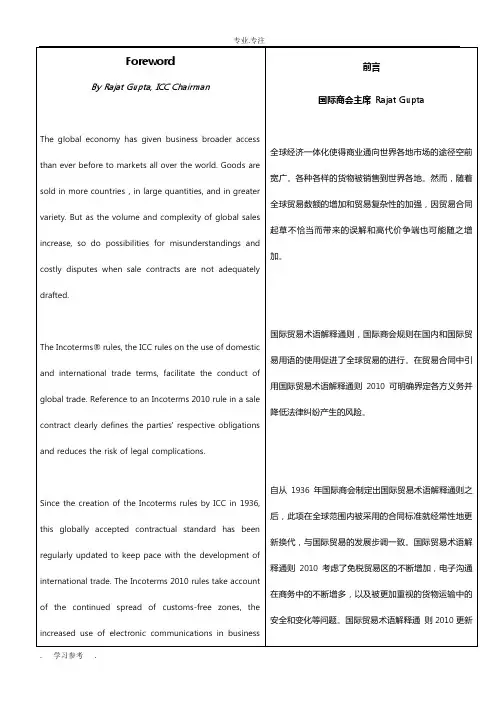
EXW (insert named place of delivery)GUIDANCE NOTEThis rule may be used irrespective of the mode of transport selected and may also be used where more than one mode of transport is employed.It is suitable for domestic trade, while FCA is usually more appropriate for international trade.“Ex Works” means that the seller delivers when it places the goods at the disposal of the buyer at the seller’s premises or at another named place (i.e., works, factory, warehouse, etc.). The seller does not need to load the goods on any collecting vehicle, nor does it need to clear the goods for export, where such clearance is applicable.The parties are well advised to specify as clearly as possible the point within the named place of delivery, as the costs and risks to that point are for the account of the seller. The buyer bears all costs and risks involved in taking the goods from the agreed point, if any, at the named place of delivery.EXW represents the minimum obligation for the seller. The rule should be used with care as:a) T he seller has no obligation to the buyer to load the goods, even though in practice the seller may be in abetter position to do so. If the seller does load the goods, it does so at the buyer’s risk and expense. In cases where the seller is in a better position to load the goods, FCA, which obliges the seller to do so at its own risk and expense, is usually more appropriate.b) A buyer who buys from a seller on an EXW basis for export needs to be aware that the seller has an obligationto provide only such assistance as the buyer may require to effect that export: the seller is not bound to organize the export clearance. Buyers are therefore well advised not to use EXW if they cannot directly or indirectly obtain export clearance.c) The buyer has limited obligations to provide to the seller any information regarding the export of the goods.However, the seller may need this information for, e.g., taxation or reporting purposes.EXW——工厂交货(……指定地点)本条规则与(当事人)所选择的运输模式无关,即便(当事人)选择多种运输模式,亦可适用该规则。
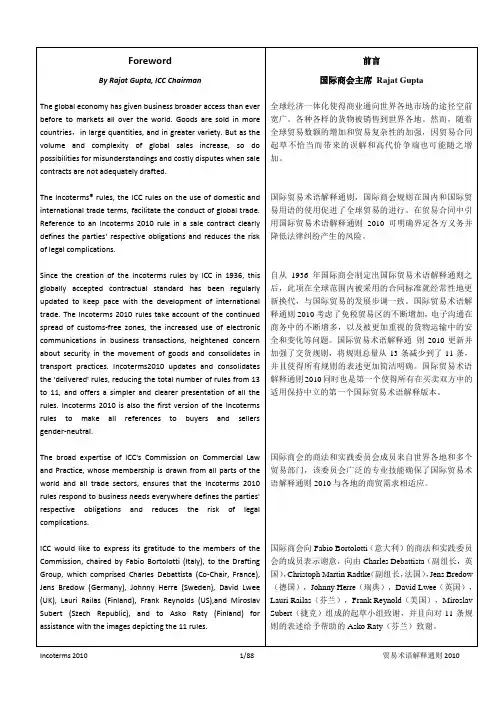
EXW (insert named place of delivery)GUIDANCE NOTEThis rule may be used irrespective of the mode of transport selected and may also be used where more than one mode of transport is employed.It is suitable for domestic trade, while FCA is usually more appropriate for international trade.“Ex Works” means that the seller delivers when it places the goods at the disposal of the buyer at the seller’s premises or a t another named place (i.e., works, factory, warehouse, etc.). The seller does not need to load the goods on any collecting vehicle, nor does it need to clear the goods for export, where such clearance is applicable.The parties are well advised to specify as clearly as possible the point within the named place of delivery, as the costs and risks to that point are for the account of the seller. The buyer bears all costs and risks involved in taking the goods from the agreed point, if any, at the named place of delivery.EXW represents the minimum obligation for the seller. The rule should be used with care as:a) The seller has no obligation to the buyer to load the goods, even though in practice the seller may be in a betterposition to do so. If the seller does load the goods, it does so at the buyer’s risk and expense. In cases where the seller i s in a better position to load the goods, FCA, which obliges the seller to do so at its own risk and expense, is usually more appropriate.b) A buyer who buys from a seller on an EXW basis for export needs to be aware that the seller has an obligation toprovide only such assistance as the buyer may require to effect that export: the seller is not bound to organize the export clearance. Buyers are therefore well advised not to use EXW if they cannot directly or indirectly obtain export clearance.c) The buyer has limited obligations to provide to the seller any information regarding the export of the goods. However,the seller may need this information for, e.g., taxation or reporting purposes.EXW——工厂交货(……指定地点)本条规则与(当事人)所选择的运输模式无关,即便(当事人)选择多种运输模式,亦可适用该规则。
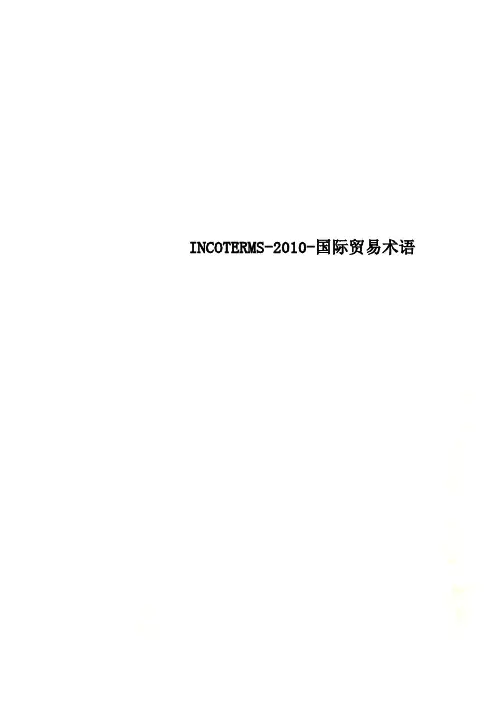
INCOTERMS-2010-国际贸易术语INCOTERMS 2010《國際貿易術語解釋通則》(以下稱 Incoterms )的宗旨是為國際貿易中最普遍使用的貿易術語提供一套解釋的國際規則,以避免因各國不同解釋而出現的不確定性,或至少在相當程度上減少這種不確定性。
合同雙方當事人之間互不瞭解對方國家的貿易習慣的情況時常出現。
這就會引起誤解、爭議、和訴訟,從而浪費時間和費用。
為解決這些問題,國際商會(ICC)於 1936 年首次公佈了一套解釋貿易術語的國際規則,名為 Incoterms 1936,隔幾年就會出個修訂版,目前最新的是第八版國貿條規 Incoterms 2010。
這些規則是因應當前國際貿易發展而制定。
The Incoterms rules or International Commercial terms are a series of pre-defined commercial terms published by the International Chamber of Commerce (ICC) widely used in international commercial transactions. A series of three-letter trade terms related to common sales practices, the Incoterms rules are intended primarily to clearly communicate the tasks, costs and risks associated with the transportation and delivery of goods. The Incoterms rules are accepted by governments, legal authorities and practitioners worldwide for the interpretation of most commonly used terms in international trade.海運和內陸河運適用的規則•FAS 船邊交貨•FOB 船上交貨•CFR 成本加運費•CIF 成本,保險費加運費通用的運輸規則•EXW 工廠交貨(...指定地點)•FCA 貨交承運人•CPT 運費付至...•CIP 運費和保險費付至...•DAT 在碼頭交貨•DAP 交貨地點•DDP 完稅後交貨注: 使用這個國際貿易術語通則時要加上地方。
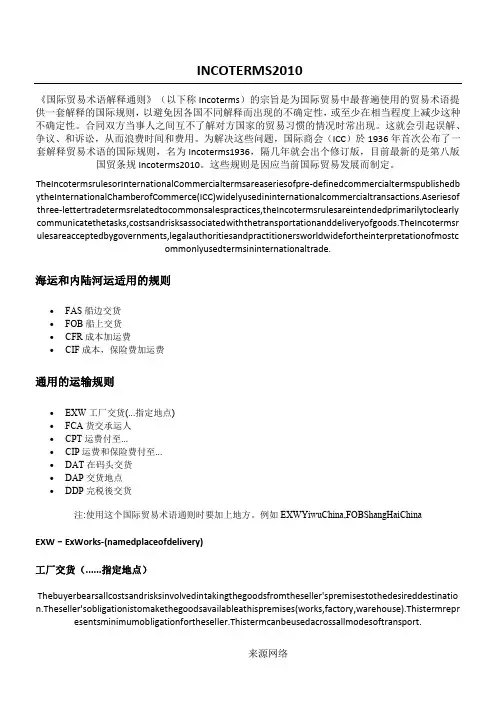
INCOTERMS2010《国际贸易术语解释通则》(以下称Incoterms)的宗旨是为国际贸易中最普遍使用的贸易术语提供一套解释的国际规则,以避免因各国不同解释而出现的不确定性,或至少在相当程度上减少这种不确定性。
合同双方当事人之间互不了解对方国家的贸易习惯的情况时常出现。
这就会引起误解、争议、和诉讼,从而浪费时间和费用。
为解决这些问题,国际商会(ICC)於1936年首次公布了一套解释贸易术语的国际规则,名为Incoterms1936,隔几年就会出个修订版,目前最新的是第八版国贸条规Incoterms2010。
这些规则是因应当前国际贸易发展而制定。
TheIncotermsrulesorInternationalCommercialtermsareaseriesofpre-definedcommercialtermspublishedb∙∙∙∙∙∙∙∙∙∙∙注:使用这个国际贸易术语通则时要加上地方。
例如EXWYiwuChina,FOBShangHaiChinaEXW–ExWorks-(namedplaceofdelivery)工厂交货(......指定地点)Thebuyerbearsallcostsandrisksinvolvedintakingthegoodsfromtheseller'spremisestothedesireddestinatio n.Theseller'sobligationistomakethegoodsavailableathispremises(works,factory,warehouse).Thistermrepr esentsminimumobligationfortheseller.Thistermcanbeusedacrossallmodesoftransport.EXW是国际贸易术语之一,可以用在所有的交通工具。
EXW是指当卖方在其所在地或其他指定的地点(如工场、工厂或仓库)将货物交给买方处置时,即完成交货,卖方不办理出口清关手续或将货物装上任何运输工具。
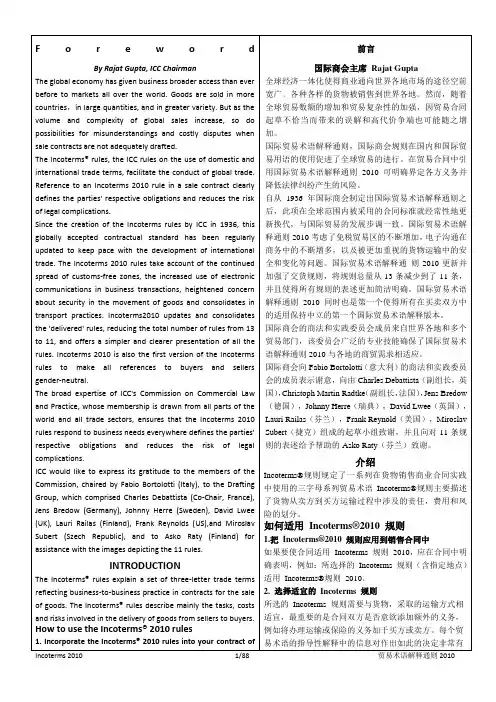
EXW (insert named place of delivery)GUIDANCE NOTEThis rule may be used irrespective of the mode of transport selected and may also be used where more than one mode of transport is employed.It is suitable for domestic trade, while FCA is usually more appropriate for international trade.“Ex Works” means that the seller delivers when it places the goods at the disposal of the buyer at the seller’s premises or at another named place (i.e., works, factory, warehouse, etc.). The seller does not need to load the goods on any collecting vehicle, nor does it need to clear the goods for export, where such clearance is applicable.The parties are well advised to specify as clearly as possible the point within the named place of delivery, as the costs and risks to that point are for the account of the seller. The buyer bears all costs and risks involved in taking the goods from theagreed point, if any, at the named place of delivery.EXW represents the minimum obligation for the seller. The rule should be used with care as:a) The seller has no obligation to the buyer to load the goods, even though in practice the seller may be in a better positionto do so. If the seller does load the goods, it does so at the buyer’s risk and expense. In cases where the seller is in a better position to load the goods, FCA, which obliges the seller to do so at its own risk and expense, is usually more appropriate.b) A buyer who buys from a seller on an EXW basis for export needs to be aware that the seller has an obligation to provideonly such assistance as the buyer may require to effect that export: the seller is not bound to organize the export clearance. Buyers are therefore well advised not to use EXW if they cannot directly or indirectly obtain export clearance. c) The buyer has limited obligations to provide to the seller any information regarding the export of the goods. However, theseller may need this information for, e.g., taxation or reporting purposes.EXW——工厂交货(……指定地点)本条规则与(当事人)所选择的运输模式无关,即便(当事人)选择多种运输模式,亦可适用该规则。
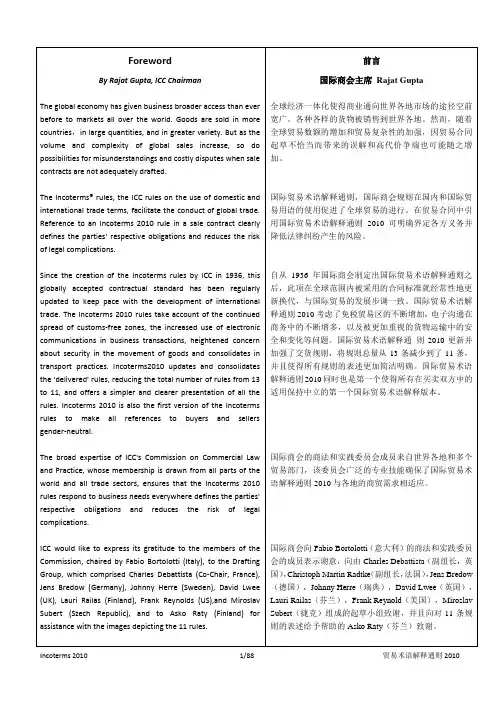
EXW (insert named place of delivery)GUIDANCE NOTEThis rule may be used irrespective of the mode of transport selected and may also be used where more than one mode of transport is employed.It is suitable for domestic trade, while FCA is usually more appropriate for international trade.“Ex Works” means that the seller delivers when it places the goods at the disposal of the buyer at the seller’s premises or a t another named place (i.e., works, factory, warehouse, etc.). The seller does not need to load the goods on any collecting vehicle, nor does it need to clear the goods for export, where such clearance is applicable.The parties are well advised to specify as clearly as possible the point within the named place of delivery, as the costs and risks to that point are for the account of the seller. The buyer bears all costs and risks involved in taking the goods from the agreed point, if any, at the named place of delivery.EXW represents the minimum obligation for the seller. The rule should be used with care as:a) The seller has no obligation to the buyer to load the goods, even though in practice the seller may be in a betterposition to do so. If the seller does load the goods, it does so at the buyer’s risk and expense. In cases where the seller i s in a better position to load the goods, FCA, which obliges the seller to do so at its own risk and expense, is usually more appropriate.b) A buyer who buys from a seller on an EXW basis for export needs to be aware that the seller has an obligation toprovide only such assistance as the buyer may require to effect that export: the seller is not bound to organize the export clearance. Buyers are therefore well advised not to use EXW if they cannot directly or indirectly obtain export clearance.c) The buyer has limited obligations to provide to the seller any information regarding the export of the goods. However,the seller may need this information for, e.g., taxation or reporting purposes.EXW——工厂交货(……指定地点)本条规则与(当事人)所选择的运输模式无关,即便(当事人)选择多种运输模式,亦可适用该规则。
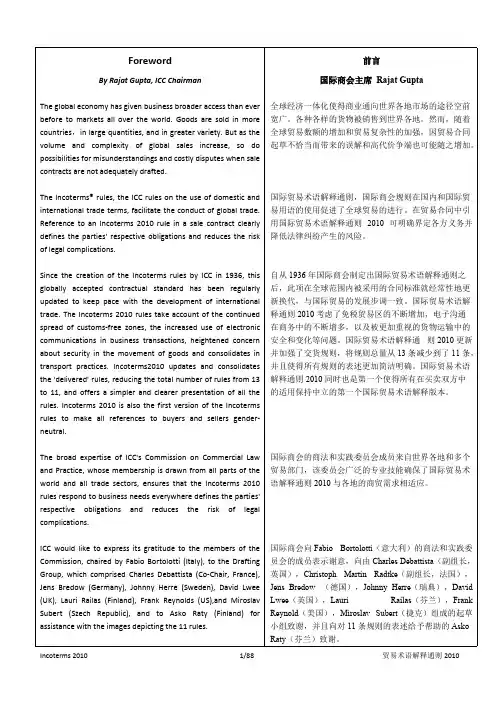
ForewordBy Rajat Gupta, ICC ChairmanThe global economy has given business broader access than ever before to markets all over the world. Goods are sold in more countries,in large quantities, and in greater variety. But as the volume and complexity of global sales increase, so do possibilities for misunderstandings and costly disputes when sale contracts are not adequately drafted.The Incoterms® rules, the ICC rules on the use of domestic and international trade terms, facilitate the conduct of global trade. Reference to an Incoterms 2010 rule in a sale contract clearly defines the parties' respective obligations and reduces the risk of legal complications.Since the creation of the Incoterms rules by ICC in 1936, this globally accepted contractual standard has been regularly updated to keep pace with the development of international trade. The Incoterms 2010 rules take account of the continued spread of customs-free zones, the increased use of electronic communications in business transactions, heightened concern about security in the movement of goods and consolidates in transport practices. Incoterms2010 updates and consolidates the 'delivered' rules, reducing the total number of rules from 13 to 11, and offers a simpler and clearer presentation of all the rules. Incoterms 2010 is also the first version of the Incoterms rules to make all references to buyers and sellers gender-neutral.The broad expertise of ICC's Commission on Commercial Law and Practice, whose membership is drawn from all parts of the world and all trade sectors, ensures that the Incoterms 2010 rules respond to business needs everywhere defines the parties' respective obligations and reduces the risk of legal complications.ICC would like to express its gratitude to the members of the Commission, chaired by Fabio Bortolotti (Italy), to the Drafting Group, which comprised Charles Debattista (Co-Chair, France), Jens Bredow (Germany), Johnny Herre (Sweden), David Lwee (UK), Lauri Railas (Finland), Frank Reynolds (US),and Miroslav Subert (Szech Republic), and to Asko Raty (Finland) for assistance with the images depicting the 11 rules.前言国际商会主席Rajat Gupta全球经济一体化使得商业通向世界各地市场的途径空前宽广。
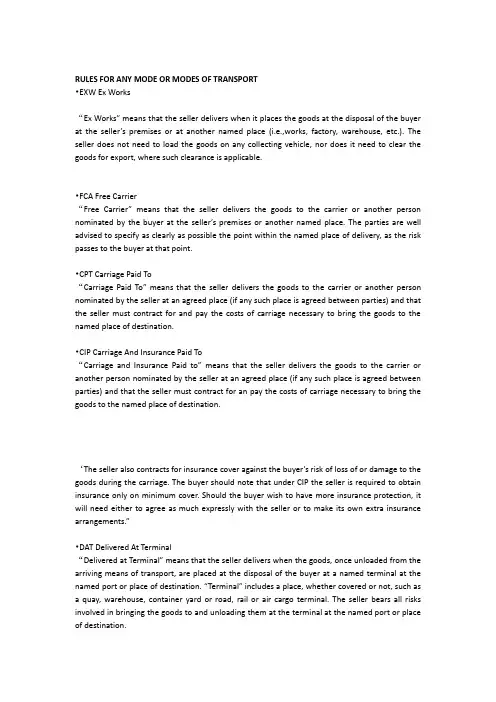
RULES FOR ANY MODE OR MODES OF TRANSPORT•EXW Ex Works“Ex Works” means that the seller delivers when it places the goods at the disposal of the buyer at the seller’s premises or at another named place (i.e.,works, factory, warehouse, etc.). The seller does not need to load the goods on any collecting vehicle, nor does it need to clear the goods for export, where such clearance is applicable.•FCA Free Carrier“Free Carrier” means that the seller delivers the goods to the carrier or another person nominated by the buyer at the seller’s premises or another na med place. The parties are well advised to specify as clearly as possible the point within the named place of delivery, as the risk passes to the buyer at that point.•CPT Carriage Paid To“Carriage Paid To” means that the seller delivers the goods to th e carrier or another person nominated by the seller at an agreed place (if any such place is agreed between parties) and that the seller must contract for and pay the costs of carriage necessary to bring the goods to the named place of destination.•CIP Carriage And Insurance Paid To“Carriage and Insurance Paid to” means that the seller delivers the goods to the carrier or another person nominated by the seller at an agreed place (if any such place is agreed between parties) and that the seller must contract for an pay the costs of carriage necessary to bring the goods to the named place of destination.‘The seller also contracts for insurance cover against the buyer’s risk of loss of or damage to the goods during the carriage. The buyer should note that under CIP the seller is required to obtain insurance only on minimum cover. Should the buyer wish to have more insurance protection, it will need either to agree as much expressly with the seller or to make its own extra insurance arrangements.”•DAT Delivered At Terminal“Delivered at Terminal” means that the seller delivers when the goods, once unloaded from the arriving means of transport, are placed at the disposal of the buyer at a named terminal at the named port or place of destination. “Terminal” includes a place, whether covered or not, such as a quay, warehouse, container yard or road, rail or air cargo terminal. The seller bears all risks involved in bringing the goods to and unloading them at the terminal at the named port or place of destination.•DAP Delivered At Place“Delivered at Place” means that the seller delivers when the goods are placed at the disposal of the buyer on the arriving means of transport ready for unloading at the named place of destination. The seller bears all risks involved in bringing the goods to the named place.•DDP Delivered Duty Paid“Delivered Duty Paid” means that the seller delivers the goods when the goods are placed at the disposal of the buyer, cleared for import on the arriving means of transport ready for unloading at the named place of destination. The seller bears all the costs and risks involved in bringing the goods to the place of destination and has an obligation to clear the goods not only for export but also for import, to pay any duty for both export and import and to carry out all customs formalities.RULES FOR SEA AND INLAND WATERWAY TRANSPORT•FAS Free Alongside Ship“Free Alongside Ship” means that the seller delivers when the goods are placed alongside the vessel (e.g., on a quay or a barge) nominated by the buyer at the named port of shipment. The risk of loss of or damage to the goods passes when the goods are alongside the ship, and the buyer bears all costs from that moment onwards.•FOB Free On Board“Free On Board” means that the seller delivers the goods on board the vessel nominated by the buyer at the named port of shipment or procures the goods already so delivered. The risk of loss of or damage to the goods passes when the goods are on board the vessel, and the buyer bears all costs from that moment onwards.•CFR Cost and Freight“Cost and Freight” means that the seller delivers the goods on board the vessel or procures the goods already so delivered. The risk of loss of or damage to the goods passes when the goods are on board the vessel. the seller must contract for and pay the costs and freight necessary to bring the goods to the named port of destination.•CIF Cost, Insurance and Freight“Cost, Insurance and Freight” means that the seller delivers the goods on board the vessel or procures the goods already so delivered. The risk of loss of or damage to the goods passes when the goods are on board the vessel. The seller must contract for and pay the costs and freight necessary to bring the goods to the named port of destination.‘The seller als o contracts for insurance cover against the buyer’s risk of loss of or damage to the goods during the carriage. The buyer should note that under CIF the seller is required to obtain insurance only on minimum cover. Should the buyer wish to have more insurance protection, it will need either to agree as much expressly with the seller or to make its own extra insurance arrangements.”。

RULES FOR ANY MODE OR MODES OF TRANSPORT•EXW Ex Works“Ex Works” means that the seller delivers when it places the goods at the disposal of the buyer at the seller’s premises or at another named place (i.e.,works, factory, warehouse, etc.). The seller does not need to load the goods on any collecting vehicle, nor does it need to clear the goods for export, where such clearance is applicable.•FCA Free Carrier“Free Carrier” means that the seller delivers the goods to the carrier or another person nominated by the buyer at the seller’s premises or another na med place. The parties are well advised to specify as clearly as possible the point within the named place of delivery, as the risk passes to the buyer at that point.•CPT Carriage Paid To“Carriage Paid To” means that the seller delivers the goods to th e carrier or another person nominated by the seller at an agreed place (if any such place is agreed between parties) and that the seller must contract for and pay the costs of carriage necessary to bring the goods to the named place of destination.•CIP Carriage And Insurance Paid To“Carriage and Insurance Paid to” means that the seller delivers the goods to the carrier or another person nominated by the seller at an agreed place (if any such place is agreed between parties) and that the seller must contract for an pay the costs of carriage necessary to bring the goods to the named place of destination.‘The seller also contracts for insurance cover against the buyer’s risk of loss of or damage to the goods during the carriage. The buyer should note that under CIP the seller is required to obtain insurance only on minimum cover. Should the buyer wish to have more insurance protection, it will need either to agree as much expressly with the seller or to make its own extra insurance arrangements.”•DAT Delivered At Terminal“Delivered at Terminal” means that the seller delivers when the goods, once unloaded from the arriving means of transport, are placed at the disposal of the buyer at a named terminal at the named port or place of destination. “Terminal” includes a place, whether covered or not, such as a quay, warehouse, container yard or road, rail or air cargo terminal. The seller bears all risks involved in bringing the goods to and unloading them at the terminal at the named port or place of destination.•DAP Delivered At Place“Delivered at Place” means that the seller delivers when the goods are placed at the disposal of the buyer on the arriving means of transport ready for unloading at the named place of destination. The seller bears all risks involved in bringing the goods to the named place.•DDP Delivered Duty Paid“Delivered Duty Paid” means that the seller delivers the goods when the goods are placed at the disposal of the buyer, cleared for import on the arriving means of transport ready for unloading at the named place of destination. The seller bears all the costs and risks involved in bringing the goods to the place of destination and has an obligation to clear the goods not only for export but also for import, to pay any duty for both export and import and to carry out all customs formalities.RULES FOR SEA AND INLAND WATERWAY TRANSPORT•FAS Free Alongside Ship“Free Alongside Ship” means that the seller delivers when the goods are placed alongside the vessel (e.g., on a quay or a barge) nominated by the buyer at the named port of shipment. The risk of loss of or damage to the goods passes when the goods are alongside the ship, and the buyer bears all costs from that moment onwards.•FOB Free On Board“Free On Board” means that the seller delivers the goods on board the vessel nominated by the buyer at the named port of shipment or procures the goods already so delivered. The risk of loss of or damage to the goods passes when the goods are on board the vessel, and the buyer bears all costs from that moment onwards.•CFR Cost and Freight“Cost and Freight” means that the seller delivers the goods on board the vessel or procures the goods already so delivered. The risk of loss of or damage to the goods passes when the goods are on board the vessel. the seller must contract for and pay the costs and freight necessary to bring the goods to the named port of destination.•CIF Cost, Insurance and Freight“Cost, Insurance and Freight” means that the seller delivers the goods on board the vessel or procures the goods already so delivered. The risk of loss of or damage to the goods passes when the goods are on board the vessel. The seller must contract for and pay the costs and freight necessary to bring the goods to the named port of destination.‘The seller als o contracts for insurance cover against the buyer’s risk of loss of or damage to the goods during the carriage. The buyer should note that under CIF the seller is required to obtain insurance only on minimum cover. Should the buyer wish to have more insurance protection, it will need either to agree as much expressly with the seller or to make its own extra insurance arrangements.”。
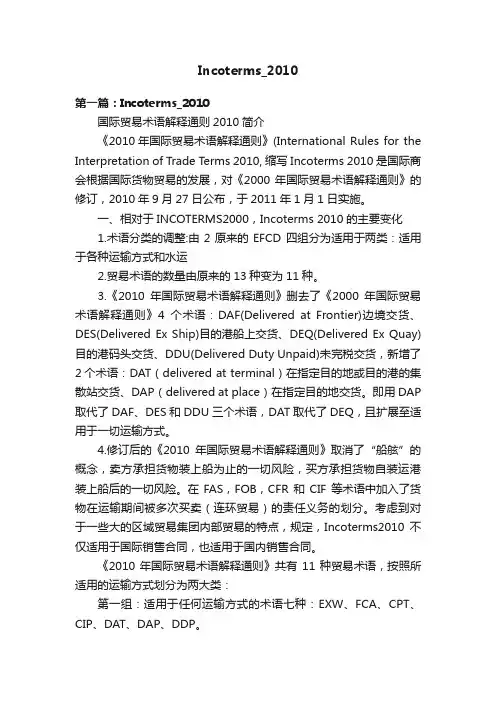
Incoterms_2010第一篇:Incoterms_2010国际贸易术语解释通则2010简介《2010年国际贸易术语解释通则》(International Rules for the Interpretation of Trade Terms 2010, 缩写Incoterms 2010 是国际商会根据国际货物贸易的发展,对《2000年国际贸易术语解释通则》的修订,2010年9月27日公布,于2011年1月1日实施。
一、相对于INCOTERMS2000,Incoterms 2010的主要变化1.术语分类的调整:由2原来的EFCD 四组分为适用于两类:适用于各种运输方式和水运2.贸易术语的数量由原来的13种变为11种。
3.《2010年国际贸易术语解释通则》删去了《2000年国际贸易术语解释通则》4个术语:DAF(Delivered at Frontier)边境交货、DES(Delivered Ex Ship)目的港船上交货、DEQ(Delivered Ex Quay)目的港码头交货、DDU(Delivered Duty Unpaid)未完税交货,新增了2个术语:DAT(delivered at terminal)在指定目的地或目的港的集散站交货、DAP(delivered at place)在指定目的地交货。
即用DAP 取代了DAF、DES和DDU三个术语,DAT取代了DEQ,且扩展至适用于一切运输方式。
4.修订后的《2010年国际贸易术语解释通则》取消了“船舷”的概念,卖方承担货物装上船为止的一切风险,买方承担货物自装运港装上船后的一切风险。
在FAS,FOB,CFR和CIF等术语中加入了货物在运输期间被多次买卖(连环贸易)的责任义务的划分。
考虑到对于一些大的区域贸易集团内部贸易的特点,规定,Incoterms2010不仅适用于国际销售合同,也适用于国内销售合同。
《2010年国际贸易术语解释通则》共有11种贸易术语,按照所适用的运输方式划分为两大类:第一组:适用于任何运输方式的术语七种:EXW、FCA、CPT、CIP、DAT、DAP、DDP。
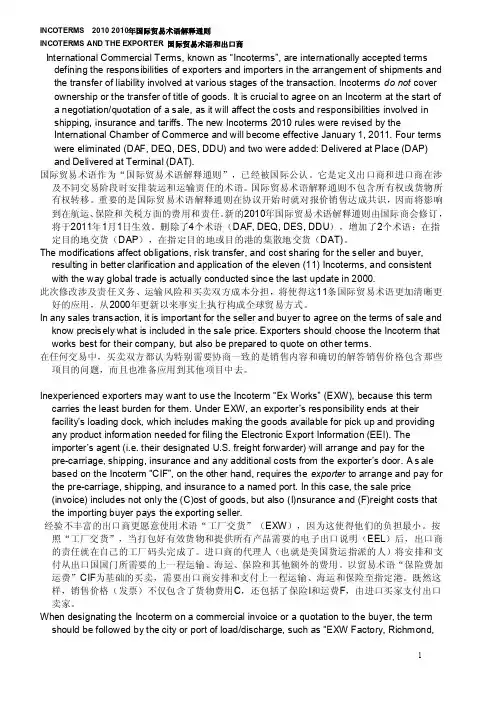
INCOTERMS 2010 2010年国际贸易术语解释通则INCOTERMS AND THE EXPORTER 国际贸易术语和出口商International Commercial Terms, known as “Incoterms”, are internationally accepted terms defining the responsibilities of exporters and importers in the arrangement of shipments and the transfer of liability involved at various stages of the transaction. Incoterms do not cover ownership or the transfer of title of goods. It is crucial to agree on an Incoterm at the start ofa negotiation/quotation of a sale, as it will affect the costs and responsibilities involved inshipping, insurance and tariffs. The new Incoterms 2010 rules were revised by theInternational Chamber of Commerce and will become effective January 1, 2011. Four terms were eliminated (DAF, DEQ, DES, DDU) and two were added: Delivered at Place (DAP) and Delivered at Terminal (DAT).国际贸易术语作为“国际贸易术语解释通则”,已经被国际公认。
2010年国际贸易术语解释通则(INCOTERMS2010)(5篇)第一篇:2010年国际贸易术语解释通则(INCOTERMS 2010) 适用于任何单一运输方式或多种运输方式的术语EXW(EX works)工厂交货FCA(Free Carrier)货交承运人CPT(Carriage Paid To)运费付至CIP(Carriage and lnsurance Paid to)运费、保险费付至DAT(Delivered At T erminal)运输终端交货DAP(Delivered At Place)目的地交货DDP(Delivered Duty Paid)完税后交货适用于海运和内河水运的术语FAS(Free Along Side)船边交货FOB(Free On Board)船上交货CFR(Cost and Freight)成本加运费CIF(Cost, Insurance and Freight)成本、保险加运费EXW(EX Works工厂交货)该术语可适用于任何运输方式,也可适用于多种运输方式。
它适合国内贸易,而FCA一般则更适合国际贸易。
“工厂交货”是指当卖方在其所在地或其它指定地点(如工厂、车间或仓库等)将货物交由买方处置时,即完成交货。
卖方不需将货物装上任何前来接收货物的运输工具,需要清关时,卖方也无需办理出口清关手续。
特别建议双方在指定交货地范围内尽可能明确具体交货地点,因为在货物到达交货地点之前的所有费用和风险都由卖方承担。
买方则需承担自此指定交货地的约定地点(如有的话)收取货物所产生的全部费用和风险。
EXW(工厂交货)术语代表卖方最低义务,使用时需注意以下问题:a)卖方对买方没有装货的义务,即使实际上卖方也许更方便这样做。
如果卖方装货,也是由买方承担相关风险和费用。
当卖方更方便装货物时,FCA一般更合适,因为该术语要求卖方承担装货义务,以及与此相关的风险和费用。
b)以EXW为基础购买出口产品的买方需要注意,卖方只有在买方要求时,才有义务协助办理出口,即卖方无义务安排出口通关。
Incoterms 2010RULES FOR ANY MODE OR MODES OF TRANSPORTEX WORKSEXW (insert named place of delivery) Incoterms 2010GUIDANCE NOTEThis rule may be used irrespective of the mode of transport selected and may also be used where more than one mode of transport is employed.It is suitable for domestic trade, while FCA is usually more appropriate for international trade. “Ex Works” means that the seller delivers when it places the goods at the disposal of the buyer at the seller’s premises or at another name d place (i.e., works, factory, warehouse, etc.). The seller does not need to load the goods on any collecting vehicle, nor does it need to clear the goods for export, where such clearance is applicable.The parties are well advised to specify as clearly as possible the point within the named place of delivery, as the costs and risks to that point are for the account of the seller. The buyer bears all costs and risks involved in taking the goods from the agreed point, if any, at the named place of delivery.EXW represents the minimum obligation for the seller. The rule should be used with care as:a) The seller has no obligation to the buyer to load the goods, even though in practice the seller may be in a better position to do so. If the seller does load the goods, it does so at the buyer’s risk and expense. In cases where the seller is in a better position to load the goods, FCA, which obliges the seller to do so at its own risk and expense, is usually more appropriate.b) A buyer who buys from a seller on an EXW basis for export needs to be aware that the seller has an obligation to provide only such assistance as the buyer may require to effect that export: the seller is not bound to organize the export clearance. Buyers are therefore well advised not to use EXW if they cannot directly or indirectly obtain export clearance.c) The buyer has limited obligations to provide to the seller any information regarding the export of the goods. However, the seller may need this information for, e.g., taxation or reporting purposes.A THE SELLER’ OBLIGATIONSA1 General obligations of the sellerThe seller must provide the goods and the commercial invoice in conformity with the contract of sale and any other evidence of conformity that may be required by the contract. Any document referred to in A1-A10 may be an equivalent electronic record or procedure if agreed between the parties or customary.A2 Licences, authorizations, security clearances and other formalities Where applicable, the seller must provide the buyer, at the buyer’s request, risk and expense, assistance in obtaining any export licence, or other official authorization necessary for the export of the goods.Where applicable, the seller must provide, at the buyer’s request, risk and expense, any information in the possession of the seller that is required for the security clearance of the goods. A3 Contracts of carriage and insurancea) Contract of carriageThe seller has no obligation to the buyer to make a contract of carriage.b) Contract of insuranceThe seller has no obligation to the buyer to make a contract of insurance. However, the seller must provide the buyer, at the buyer’s request, risk and expense (if any), with information that the buyer needs for obtaining insurance.A4 DeliveryThe seller must deliver the goods by placing them at the disposal of the buyer at the agreed point, if any, at the named place of delivery, not loaded on any collecting vehicle. If no specific point has been agreed within the named place of delivery, and if there are several points available, the seller may select the point that best suits its purpose. The seller must deliver the goods on the agreed date or within the agreed period.B THE BUYER’ OBLIGATIONSB1 General obligations of the buyerThe buyer must pay the price of the goods as provided in the contract of sale.Any document referred to in B1-B10 may be an equivalent electronic record or procedure if agreed between the parties or customary.B2 Licences, authorizations, security clearances and other formalitiesWhere applicable, it is up to the buyer to obtain, at its own risk and expense, any export and import licence or other official authorization and carry out all customs formalities for the export of the goods.B3 Contracts of carriage and insurancea) Contract of carriageThe buyer has no obligation to the seller to make a contract of carriage.b) Contract of insuranceThe buyer has no obligation to the seller to make a contract of insurance.B4 Taking deliveryThe buyer must take delivery of the goods when A4 and A7 have been complied with.A5 Transfer of risksThe seller bears all risks of loss of or damage to the goods until they have been delivered in accordance with A4 with the exception of loss or damage in the circumstances described inB5.A6 Allocation of costsThe seller must pay all costs relating to the goods until they have been delivered in accordance with A4, other than those payable by the buyer as envisaged in B6.A7 Notices to the buyerThe seller must give the buyer any notice needed to enable the buyer to take delivery of the goods. A8 Delivery documentThe seller has no obligation to the buyer.B5 Transfer of risksThe buyer bears all risks of loss of or damage to the goods from the time they have been delivered as envisaged in A4. If the buyer fails to give notice in accordance with B7, then thebuyer bears all risks of loss of or damage to the goods from the agreed date or the expiry date of the agreed period for delivery, provided that the goods have been clearly identified as thecontract goods.B6 Allocation of costsThe buyer must:a) pay all costs relating to the goods from the time they have been delivered as envisaged in A4;b)pay any additional costs incurred by failing either to take delivery of the goods when they have been placed at its disposal or to give appropriate notice in accordance with B7, provided that the goods have been clearly identified as the contract goods;c)pay, where applicable, all duties, taxes and other charges, as well as the costs of carrying out customs formalities payable upon export; andd) reimburse all costs and charges incurred by the seller in providing assistance as envisaged in A2.B7 Notices to the sellerThe buyer must, whenever it is entitled to determine the time within an agreed period and/or the point of taking delivery within the named place, give the seller sufficient notice thereof.B8 Proof of deliveryThe buyer must provide the seller with appropriate evidence of having taken delivery.A9 Checking –packaging –markingThe seller must pay the costs of those checking operations (such as checking quality, measuring, weighing, and counting) that are necessary for the purpose of delivering the goods in accordance with A4.The seller must, at its own expense, package the goods, unless it is usual for the particular trade to transport the type of goods sold unpackaged. The seller may package the goods in the manner appropriate for their transport, unless the buyer has notified the seller of specific packaging requirements before the contract of sale is concluded. Packaging is to be marked appropriately.A10 Assistance with information and related costsThe seller must, where applicable, in a timely manner, provide to or render assistance in obtaining for the buyer, at the buyer’s request, risk and expense, any documents and information, including security-related information, that the buyer needs for the export and/or import of the goods and/or for their transport to the final destination.B9 Inspection of goodsThe buyer must pay the costs of any mandatory pre-shipment inspection, including inspection mandated by the authorities of the country of export.B10 Assistance with information and related costsThe buyer must, in a timely manner, advise the seller of any security information requirements so that the seller may comply with A10.The buyer must reimburse the seller for all costs and charges incurred by the seller in providing or rendering assistance in obtaining documents and information as envisaged in A10.Free CarrierFCA (insert named place of delivery) Incoterms 2010GUIDANCE NOTEThis rule may be used irrespective of the mode of transport selected and may also be used where more than one mode of transport is employed. “Free Carrier” means that the seller delivers the goods to the carrier or anothe r person nominated by the buyer at the seller’s premises or another named place. The parties are well advised to specify as clearly as possible the point within thenamed place of delivery, as the risk passes to the buyer at that point. If the parties intend to deliver the goods at the seller’s premises, they should identify the address of those premises as the named place of delivery. If, on the other hand, the parties intend the goods to be delivered at another place, they must identify a different specific place of delivery.FCA requires the seller to clear the goods for export, where applicable. However, the seller has no obligation to clear the goods for import, pay any import duty or carry out any import customs formalities.A THE SELLER’ OBLIGATIONSA1 General obligations of the sellerThe seller must provide the goods and the commercial invoice in conformity with the contract of sale and any other evidence of conformity that may be required by the contract.Any document referred to in A1-A10 may be an equivalent electronic record or procedure if agreed between the parties or customary.A2 Licences, authorizations, security clearances and other formalitiesWhere applicable, the seller must obtain, at its own risk and expense, any export licence or other official authorization and carry out all customs formalities necessary for the export of the goods.A3 Contracts of carriage and insurancea) Contract of carriageThe seller has no obligation to the buyer to make a contract of carriage. However, if requested by the buyer or if it is commercial practice and the buyer does not give an instruction to the contrary in due time, the seller may contract for carriage on usual terms at the buyer’s risk and expense. In either case, the seller may decline to make the contract of carriage and, if it does, shall promptly notify the buyer.b) Contract of insuranceThe seller has no obligation to the buyer to make a contract of insurance. However, the seller must provide the buyer, at the buyer’s request, risk, and expens e (if any), with information thatthe buyer needs for obtaining insurance.A4 DeliveryThe seller must deliver the goods to the carrier or another person nominated by the buyer at the agreed point, if any, at the named place on the agreed date or within the agreed period.Delivery is completed:a) If the named place is the seller’s premises, when the goods have been loaded on the means of transport provided by the buyer.b) In any other case, when the goods are placed at the disposal of the carrier or another person nominated by the buyer on the seller’s means of transport ready for unloading.If no specific point has been notified by the buyer under B7 d) within the named place of delivery, and if there are several points available, the seller may select the point that best suits its purpose.B THE BUYER’ OBLIGATIONSB1 General obligations of the buyerThe buyer must pay the price of the goods as provided in the contract of sale.Any document referred to in B1-B10 may be an equivalent electronic record or procedure if agreed between the parties or customary.B2 Licences, authorizations, security clearances and other formalitiesWhere applicable, it is up to the buyer to obtain, at its own risk and expense, any import licence or other official authorization and carry out all customs formalities for the import of the goods and for their transport through any country.B3 Contracts of carriage and insurancea) Contract of carriageThe buyer must contract at its own expense for the carriage of the goods from the named place of delivery, except when the contract of carriage is made by the seller as provided for in A3 a).b) Contract of insuranceThe buyer has no obligation to the seller to make a contract of insurance.B4 Taking deliveryThe buyer must take delivery of the goods when they have been delivered as envisaged in A4. Unless the buyer notifies the seller otherwise, the seller may deliver the goods for carriage in such a manner as the quantity and/or nature of the goods may require.A5 Transfer of risksThe seller bears all risks of loss of or damage to the goods until they have been delivered in accordance with A4, with the exception of loss or damage in the circumstances described inB5.A6 Allocation of costsThe seller must paya) all costs relating to the goods until they have been delivered in accordance with A4, other than those payable by the buyer as envisaged in B6; andb) where applicable, the costs of customs formalities necessary for export, as well as all duties, taxes, and other charges payable upon export.B5 Transfer of risksThe buyer bears all risks of loss of or damage to the goods from the time they have been delivered as envisaged in A4.Ifa) the buyer fails in accordance with B7 to notify the nomination of a carrier or another person as envisaged in A4 or to give notice; orb) the carrier or person nominated by the buyer as envisaged in A4 fails to take the goods into its charge, then, the buyer bears all risks of loss of or damage to the goods:(i) from the agreed date, or in the absence of an agreed date,(ii) from the date notified by the seller under A7 within the agreed period; or, if no such date has been notified,(iii) from the expiry date of any agreed period for delivery, provided that the goods have been clearly identified as the contract goods.B6 Allocation of costsThe buyer must paya) all costs relating to the goods from the time they have been delivered as envisaged in A4, except, where applicable, the costs of customs formalities necessary for export, as well as all duties, taxes, and other charges payable upon export as referred to in A6 b);b) any additional costs incurred, either because:(i) the buyer fails to nominate a carrier or another person as envisaged in A4, or(ii) the carrier or person nominated by the buyer as envisaged in A4 fails to take the goods into its。
Incoterms 2010Incoterms 2010(国际贸易术语解释)是国际贸易中常用的国际商事术语解释规则。
它由国际商会(ICC)制定,旨在统一全球贸易中商业合同中关于交货方式、运输责任和支付义务的术语解释。
这些规则为国际贸易中的进出口商、物流提供商和仲裁人员提供了一个统一的语言和参考。
一、什么是Incoterms?Incoterms是国际贸易术语解释的简称,全称为International Commercial Terms(国际商事术语解释)。
它是一组国际上通用的贸易术语,用于规范国际贸易合同中涉及到交货方式、责任分担和相关的支付义务等内容。
Incoterms是国际贸易中非常重要的一部分,对于国际贸易中的买卖双方都具有指导作用。
二、为什么需要Incoterms?在国际贸易中,买卖双方通常处于不同的国家,涉及到跨国运输、关税和各种法律法规的规定。
为了确保国际贸易的顺利进行,需要明确双方在交货方式、风险分担和支付义务等方面的责任和权利。
这就需要一个统一的准则,使得各方能够清晰地了解各自的权益和义务。
Incoterms就是为了满足这个需求而产生的。
三、Incoterms 2010的特点Incoterms 2010是国际商会(ICC)于2010年发布的最新版本的国际贸易术语解释。
相对于之前的版本,Incoterms 2010做出了一些重要的变化和修订。
以下是一些值得注意的特点:1.更新了术语的名称和定义,使其更符合现代国际贸易的实际情况;2.修订了一些规则,使其更加清晰和易于理解;3.引入了两个新的术语:DAT(Delivered at Terminal)和DAP(Delivered at Place),以适应现代物流和货运方式的发展;4.针对电子商务等新兴业态做出了相应的调整;5.强调风险分担的重要性,明确了各个术语下的买卖双方的责任和义务。
Incoterms 2010对于国际贸易中的各方具有重要的意义,它能够提供一个统一的解释和准则,使得交易双方能够在全球范围内进行交易,并能够清晰地了解各自的权益和义务。
年国际贸易术语解释通则-(INCOTERMS)————————————————————————————————作者:————————————————————————————————日期:《2010年国际贸易术语解释通则》INCOTERMS○R2010(国际商会第715号出版物)2010年1月1日起实施DAT(insert named terminal at port or place of destination)INCOTERMS○R2010终点站交货(填写目的港或目的地指定终点站)引言本术语可适用于任何运输方式,包括多式运输在内。
“终点站交货”是指卖方在指定目的港或目的地的指定终点站,将货物从到达的运输工具上卸下并交由买方处置时,即完成交货义务。
“终点站”包括任何地方,不论是露天的或有遮蔽的,例如码头、仓库、集装箱堆场或公路、铁路或航空货运站。
卖方负担将货物运至指定目的港或目的地终点站和卸货过程中的一切风险。
当事人应尽可能清楚地指明终点站,如果可能,指明在指定目的港或目的地内的一个特定地点,因为至该地点的风险归卖方负担。
卖方应取得一份符合该要求的具体的运输契约。
此外,如果当事人希望卖方将货物自该终点站运送至另一地方,并负担运送和处理货物的一切风险和费用,则应使用DAP 或DDP 术语。
DA T术语要求卖方在清关适用的地方办理货物出口清关。
然而,卖方并无义务办理货物进口清关,支付任何进口关税或办理任何进口海关手续。
A卖方义务B 买方义务A1 卖方的一般义务卖方必须提供符合买卖合同要求的货物和商业发票,以及按合同规定需提供的任何其他证明货物符合合同的凭证。
A1至A10中所提及的任何单据,如当事人协商一致或者已另有惯例,均可为具有同等效力的电子记录或程序。
.B1 买方的一般义务买方必须依照买卖合同规定支付价款。
B1至B10中所提及的任何单据,如当事人协商一致或者已另有惯例,均可为具有同等效力的电子记录或程序。
2010年国际贸易术语解释通则《2010年国际贸易术语解释通则》(The Incoterms rules or International Commercial Terms2010)简称“Incoterms 2010”(中文又称之为“2010通则”,下同),是国际商会根据国际货物贸易的发展对《2000年国际贸易术语解释通则》的修订版本,于2010年9月27日公布,2011年1月1日开始在全球范围内实施,《2010通则》较《2000通则》更准确标明各方承担货物运输风险和费用的责任条款,令船舶管理公司更易理解货物买卖双方支付各种收费时的角色,有助于避免现时经常出现的码头处理费(THC)纠纷。
此外,新通则亦增加大量指导性贸易解释和图示,以及电子交易程序的适用方式。
虽然2010通则于2011年1月1日正式生效,但并非2000通则就自动作废。
因为国际贸易惯例本身不是法律,对国际贸易当事人不产生必然的强制性约束力。
国际贸易惯例在适用的时间效力上并不存在“新法取代旧法”的说法,即2010通则实施之后并非2000通则就自动废止,当事人在订立贸易合同时仍然可以选择适用2000通则甚至1990通则。
中文名•2010年国际贸易术语解释通则外文名•INCOTERMS® 2010概述编辑国际商会重新编写的《2010年国际贸易术语解释通则》(INCOTERMS® 2010,2010通则),是国际商会根据国际货物贸易的发展,对2000通则的修订,2010年9月27日公布,于2011年1月1日开始全球实施,2010通则较2000通则更准确标明各方承担货物运输风险和费用的责任条款,令船舶管理公司更易理解货物买卖双方支付各种收费时的角色,有助于避免现时经常出现的码头处理费(THC)纠纷。
此外,新通则亦增加大量指导性贸易解释和图示,以及电子交易程序的适用方式。
虽然2010通则于2011年1月1日正式生效,但并非2000通则就自动作废。
2010新版国际贸易术语解释通则(中英文版)D前言Incoterms 2010规则阐释了一系列在货物销售商业(商事)合同实践中使用的三字母系列贸易术语。
Incerotms 2010规则主要描述货物从卖方到买方运输过程中涉及的义务、费用和风险的分配。
如何运用Incoterms®2010规则1.将Incoterms®2010规则订入到你的销售合同中如果你要使Incoterms规则2010在你的合同中适用,你应该在合同中,通过如“所选择的Incoterms 规则(含指定地点)附上Incoterms规则2010”这类文字以明确表示。
2.选择适当的Incoterms规则所选的Incoterms规则须与货物、其运输方式相称,最重要的是与合同双方是否有意添加额外义务相称,例如安排运输或保险的义务于买方或卖方。
每个对贸易术语的指导性解释中都包含对做出此项决定非常有帮助的信息。
不论是哪一项Incoterms规则被选用,适用双方应该意识到对合同的说明会颇受到所用港口或地方特有的惯例影响。
3.尽可能精准地说明你所在地方或港口名称仅当当事人双方选定特定的一个收货地或港口时,所选术语才能发挥作用。
且地点或港口名称尽可能精准,Incoterms规则效用就能发挥到极致。
以下精准详述就是一个很好的例子:Incoterms 2010,FCA规则,法国,巴黎,38 Cours Albert 1er在Incoterms规则下:EXW 工厂交货(……指定地点)FCA 货交承运人(……指定地点)”DAT 终点站交货(……指定目的地)DAP 地点交货(……指定目的地)DDP 完税后交货(……指定目的地)FAS 船边交货(……指定装运港)FOB 船上交货(……指定装运港)此处所指地点为交货地点,同时风险也从卖方转移至买方。
Incoterms规则下CPT (运费付至),CIP (运费、保险费付至),CFR(成本加运费),CIF (成本、保险费加运费),所指地点因交货地不同而不同。
The Incoterms 2010 rulesEx Works (EXW)Can be used for any transport mode, or where there is more than one transport modeThis rule places minimum responsibility on the seller, who merely has to make the goods available, suitably packaged, at the specified place, usually the seller’s factory or depot.The buyer is responsible for loading the goods onto a vehicle (even though the seller may be better placed to do this); for all export procedures; for onward transport and for all costs arising after collection of the goods.In many cross-border transactions, this rule can present practical difficulties. Specifically, the exporter may still need to be involved in export reporting and clearance processes, and cannot realistically leave these to the buyer. Consider Free Carrier (seller’s premises) instead.Other things to watch for. Although the seller is not obliged to load the goods, if the seller does so, this is at the buyer’s risk!Free Carrier (FCA)Can be used for any transport mode, or where there is more than one transport mode.A very flexible rule that is suitable for all situations where the buyer arranges the main carriageFor example:∙Seller arranges pre-carriage from seller’s depot to the named place, which can be a terminal or transport hub, forwarder’s warehouse etc. Delivery and transfer of risk takes place when the truck or other vehicle arrives at this place, ready for unloading – in other words, the carrier is responsible for unloading the goods. (If there is more than one carrier, then risk transfers on delivery to the first carrier.)∙Where the named place is the seller’s premises, then the seller is responsible for loading the goods onto the truck etc. NB this is an important difference from Ex Works EXWIn all cases, the seller is responsible for export clearance; the buyer assumes all risks and costs after the goods have been delivered at the named place. FCA is the rule of choice for containerised goods where the buyer arranges for the main carriage.Carriage Paid T o (CPT)Can be used for any transport mode, or where there is more than one transport mode.The seller is responsible for arranging carriage to the named place, but not for insuring the goods to the named place. However delivery of the goods takes place, and risk transfers from seller to buyer, at the point where the goods are taken in charge by a carrier – see delivery.Things to watch for.Terminal Handling Charges (THC) are charges made by the terminal operator. These charges may or may not be included by the carrier in their freight rates – the buyer should enquire whether the CPT price includes THC, so as to avoid surprises.The buyer may wish to arrange insurance cover for the main carriage, starting from the point where the goods are taken in charge by the carrier – NB this will not be the place referred to in the Incoterms rule, but will be specified elsewhere within the commercial agreementSee also “Carriage and Insurance Paid T o CIP”Carriage and Insurance Paid T o (CIP)Can be used for any transport mode, or where there is more than one transport mode. The seller is responsible for arranging carriage to the named place, and also for insuring the goods.As with CPT, delivery of the goods takes place, and risk transfers from seller to buyer, at the point where the goods are taken in charge by a carrier –see delivery.Things to watch for.Terminal Handling Charges (THC) are charges made by the terminal operator. These charges may or may not be included by the carrier in their freight rates – the buyer should enquire whether the CPT price includes THC, so as to avoid surprises.Although the seller is obliged to arrange for insurance for the journey, the rule only requires a minimum level of cover, which may be commercially unrealistic. Therefore the level of cover may need to be addressed elsewhere in the commercial agreementSee also “Carriage Paid T o CPT”Delivered at T erminal (DAT)Can be used for any transport mode, or where there is more than one transport mode. The seller is responsible for arranging carriage and for delivering the goods, unloaded from the arriving conveyance, at the named place.Risk transfers from seller to buyer when the goods have been unloaded.‘T erminal’ can be any place – a quay, container yard, warehouse or transport hub.The buyer is responsible for import clearance and any applicable local taxes or import duties.Things to watch for:The place for delivery should be specified as precisely as possible, as many ports and transport hubs are very large.A useful rule, well suited to container operations where the seller bears responsibility for the main carriage.Delivered at Place (DAP)Can be used for any transport mode, or where there is more than one transport mode.The seller is responsible for arranging carriage and for delivering the goods, ready for unloading from the arriving conveyance, at the named place. (An important difference from Delivered At T erminal DAT, where the seller is responsible for unloading.)Risk transfers from seller to buyer when the goods are available for unloading; so unloading is at the buyer’s risk.The buyer is responsible for import clearance and any applicable local taxes or import duties.This rule can often be used to replace the Incoterms 2000 rules Delivered At Frontier (DAF), Delivered Ex Ship (DES) and Delivered Duty Unpaid (DDU)Delivered Duty Paid (DDP)Can be used for any transport mode, or where there is more than one transport mode.The seller is responsible for arranging carriage and delivering the goods at the named place, cleared for import and all applicable taxes and duties paid (e.g. VAT, GST)Risk transfers from seller to buyer when the goods are made available to the buyer, ready for unloading from the arriving conveyanceThis rule places the maximum obligation on the seller, and is the only rule that requires the seller to take responsibility for import clearance and payment of taxes and/or import duty.These last requirements can be highly problematical for the seller. In some countries, import clearance procedures are complex and bureaucratic, and so best left to the buyer who has local knowledge.Free Alongside Ship (FAS)Use of this rule is restricted to goods transported by sea or inland waterway.In practice it should be used for situations where the seller has direct access to the vessel for loading, e.g. bulk cargos or non-containerised goods.For containerised goods, consider “Free Carrier FCA” instead.Seller delivers goods, cleared for export, alongside the vessel at a named port, at which point risk transfers to the buyer.The buyer is responsible for loading the goods and all costs thereafter.Free On Board (FOB)Use of this rule is restricted to goods transported by sea or inland waterway.In practice it should be used for situations where the seller has direct access to the vessel for loading, e.g. bulk cargos or non-containerised goods.For containerised goods, consider “Free Carrier FCA” instead.Seller delivers goods, cleared for export, loaded on board the vessel at the named port.Once the goods have been loaded on board, risk transfers to the buyer, who bears all costs thereafter.Cost and Freight (CFR)Use of this rule is restricted to goods transported by sea or inland waterway.In practice it should be used for situations where the seller has direct access to the vessel for loading, e.g. bulk cargos or non-containerised goods.For containerised goods, consider ‘Carriage Paid T o CPT’ instead.Seller arranges and pays for transport to named port. Seller delivers goods, cleared for export, loaded on board the vessel.However risk transfers from seller to buyer once the goods have been loaded on board, i.e. before the main carriage takes place.NB seller is not responsible for insuring the goods for the main carriage.See also “Cost Insurance and Freight CIF”Cost Insurance and Freight (CIF)Use of this rule is restricted to goods transported by sea or inland waterway.In practice it should be used for situations where the seller has direct access to the vessel for loading, e.g. bulk cargos or non-containerised goods.For containerised goods, consider ‘Carriage and Insurance Paid CIP’ instead.Seller arranges and pays for transport to named port. Seller delivers goods, cleared for export, loaded on board the vessel.However risk transfers from seller to buyer once the goods have been loaded on board, i.e. before the main carriage takes place.Seller also arranges and pays for insurance for the goods for carriage to the named port.However as with “Carriage and Insurance Paid T o”, the rule only require a minimum level of cover, which may be commercially unrealistic. Therefore the level of cover may need to be addressed elsewhere in the commercial agreement.。